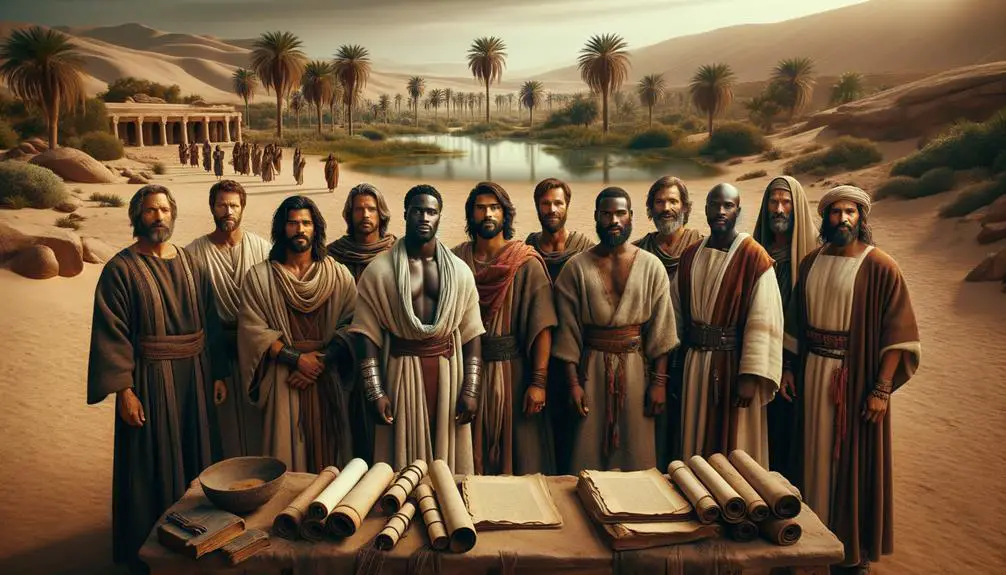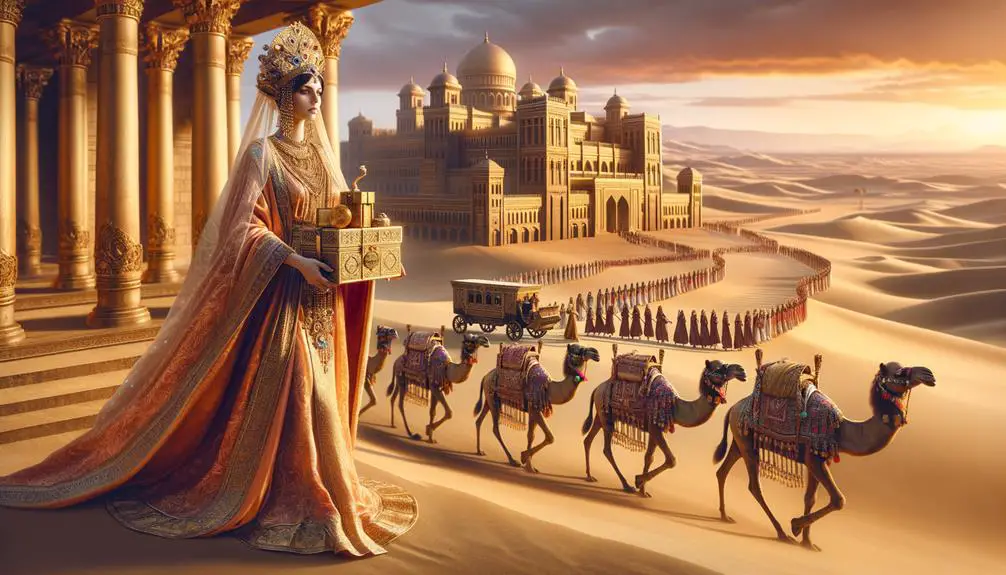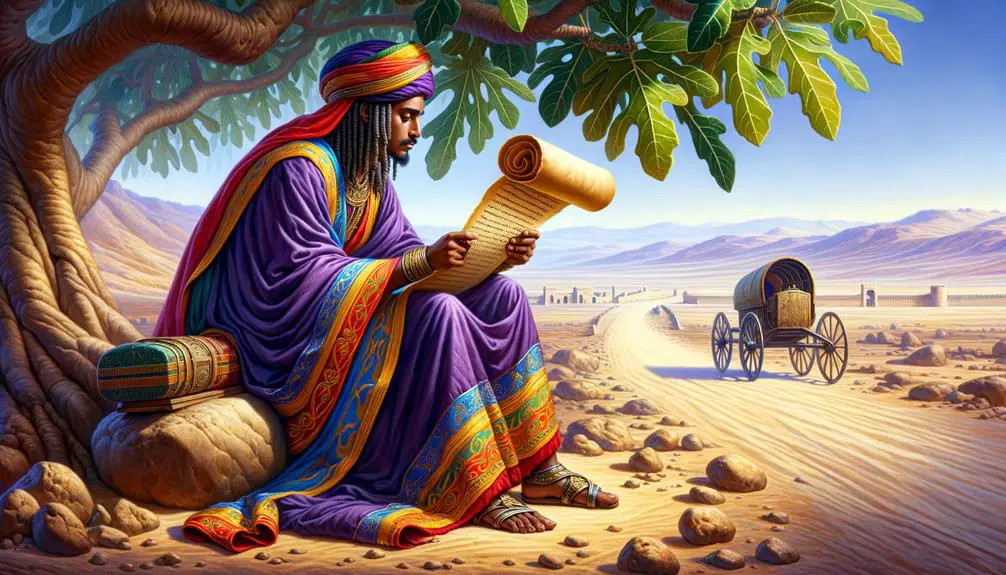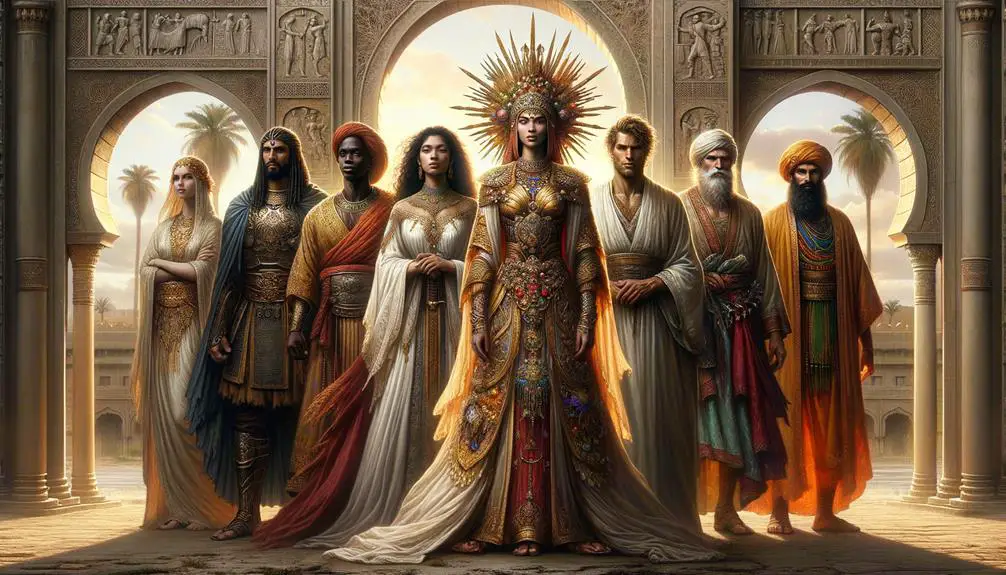Discover the captivating stories of Black individuals in the Bible, from the Queen of Sheba to Moses' Cushite wife, and their profound impact.

Who Are the Black People in the Bible
Did you know that over 100 verses in the Bible mention Kush, often associated with modern-day Ethiopia and regions of Africa? This historical link suggests a rich presence of Black individuals whose stories have woven into the biblical narrative.
You've likely heard of the Queen of Sheba's visit to King Solomon, but what about Moses' Cushite wife or the Ethiopian eunuch who encountered Philip? These characters bring a diverse tapestry of experiences and backgrounds to the forefront.
To fully appreciate their impact and significance, let's explore the depth of their contributions and how they shaped biblical history.
Key Takeaways
- The Queen of Sheba exemplifies the rich presence of Black individuals in biblical narratives, underscoring cultural interconnectedness.
- Moses' Cushite wife signifies the Bible's recognition of unions crossing cultural and racial boundaries.
- The Ethiopian Eunuch's story in Acts highlights the early Christian movement's inclusivity towards Africans.
- Simon of Cyrene's involvement in Jesus' crucifixion represents a blend of African influences within biblical events.
The Queen of Sheba

Among the notable Black figures in the Bible, the Queen of Sheba stands out for her significant diplomatic and trade expedition to King Solomon's Israel, showcasing the interconnectedness of ancient African and Middle Eastern societies. This journey isn't merely a footnote in history; it's a testament to Sheba's legacy, which has been woven into the cultural and historical tapestry of both regions.
You'd find that the Queen of Sheba's visit to Solomon wasn't just a casual encounter. It was a carefully calculated diplomatic mission, aimed at exploring potential trade routes and establishing political alliances. The narrative underscores the importance of trade in ancient times, highlighting how kingdoms sought economic prosperity through the establishment of trade routes. These routes weren't merely economic channels but were conduits of cultural exchange, allowing for the transfer of knowledge, technology, and customs between diverse peoples.
Sheba's legacy, therefore, transcends her meeting with Solomon. It's reflected in the subsequent flourishing of trade routes that linked the Horn of Africa to the Levant. This network facilitated the exchange of goods such as spices, gold, and ivory, contributing to the economic vitality of the region. Moreover, Sheba's story highlights the role of women in diplomacy and trade in ancient times, challenging contemporary perceptions of historical power dynamics.
In analyzing Sheba's legacy, it's clear that her diplomatic mission had far-reaching implications, not only for her kingdom but also for the broader interconnectivity of ancient civilizations. Through trade routes, she fostered economic, cultural, and political linkages that shaped the course of history, underscoring the complexity and dynamism of ancient African and Middle Eastern societies.
Moses' Cushite Wife
Shifting focus to another noteworthy figure, let's examine Moses' Cushite wife, whose story adds another layer to our understanding of African presence and influence in biblical narratives. Her identity, often debated, is mentioned briefly in the Bible, specifically in Numbers 12:1. This passage highlights not only her marriage to Moses but also the controversy it stirred among his siblings, Aaron and Miriam. This incident opens a window into the complex interplay of cultural implications and marriage dynamics within the text.
The term 'Cushite' historically refers to individuals from the region of Cush, an area associated with present-day Ethiopia or Nubia. Thus, Moses' marriage to a Cushite woman signifies a union that crossed geographical and cultural boundaries, challenging the prevailing notions of identity and alliance within the ancient Israelite community. This cross-cultural marriage invites readers to ponder the broader societal attitudes towards racial and ethnic diversity existing at the time.
Analyzing the cultural implications, this narrative segment reveals the presence of African individuals in significant roles and their integration into the biblical story, thereby enriching our understanding of the ancient Near East's racial and cultural tapestry. Moreover, the marriage dynamics exhibited in this account underscore the complexities of familial and societal relationships when confronted with cross-cultural unions.
The Ethiopian Eunuch

You'll find the Ethiopian Eunuch's story in the Acts of the Apostles significant for understanding the early Christian movement's inclusivity. His encounter with Philip underscores the spread of Christianity beyond Jewish communities, highlighting the universal message of the Gospel.
Analyzing this account provides insight into the historical context and the broader implications for the church's outreach to diverse peoples.
Historical Context
In the narrative of the Ethiopian Eunuch found in the Acts of the Apostles, we encounter a significant example of early Christian outreach to African individuals. This account holds considerable weight in discussions about racial interpretations and archaeological findings within biblical scholarship.
To understand this context fully, consider the following:
- Racial Interpretations: Scholars analyze the Ethiopian's representation, exploring how early Christians perceived race and ethnicity.
- Archaeological Findings: Excavations in ancient Ethiopia and the broader region provide insights into the historical connections between Africa and early Christianity.
- Cultural Exchanges: The interaction between the eunuch and Philip highlights the cultural and religious exchanges occurring at the time.
This analytical approach offers a nuanced understanding of the Ethiopian Eunuch's story beyond its surface narrative.
Significance in Acts
Building on our understanding of the historical context, let's examine the Ethiopian Eunuch's significance in the Acts of the Apostles, highlighting its pivotal role in the early Christian outreach to African individuals. This interaction not only underscores the inclusivity of Apostolic Missions but also marks a foundational moment for Ethiopian Christianity.
Aspect |
Significance |
|---|---|
Ethiopian Eunuch |
Represents early African conversion, highlighting inclusivity. |
Apostolic Missions |
Demonstrates the outreach's broad scope beyond Jewish communities. |
Philip's Role |
Symbolizes direct apostolic involvement in spreading Christianity. |
Baptism |
Acts as a ceremonial acknowledgment of faith across diverse communities. |
Ethiopian Christianity |
Traces its roots back to this significant encounter, enriching its heritage. |
This account is pivotal, showcasing the early church's commitment to a universal message of faith and salvation.
Ebed-Melech the Ethiopian
Ebed-Melech the Ethiopian emerges as a distinctive figure in the biblical narrative, showcasing the presence and significant contributions of Black individuals in the Bible. His story is deeply intertwined with Ethiopian traditions, hinting at the broader connections between the Bible's stories and the diverse cultures within it. Melech's lineage, although not extensively detailed in the scriptures, is significant as it underlines the Ethiopian presence and influence during biblical times.
To fully appreciate the role of Ebed-Melech, consider the following aspects:
- Historical Context: Ebed-Melech serves within the royal palace in Jerusalem, indicating that Ethiopians held positions of influence and were integral to the societal framework of the time. This context challenges modern perceptions of historical racial dynamics and highlights the multicultural nature of ancient civilizations.
- Ethiopian Traditions: His story enriches our understanding of Ethiopian traditions and their connection to the biblical narrative. The acknowledgment of Melech's Ethiopian identity underscores the interconnectedness of African history with the biblical world, offering insights into the cultural exchanges that occurred.
- Symbolic Representation: Ebed-Melech represents courage and righteousness, standing up for the prophet Jeremiah when others sought his harm. His actions exemplify the moral themes prevalent throughout the Bible, serving as a reminder of the universal call to justice and compassion, irrespective of one's ethnic or cultural background.
Analyzing Ebed-Melech's story through these lenses provides a richer understanding of the Bible's inclusive nature, emphasizing the significant role that Black individuals, like the Ethiopian Ebed-Melech, played in its narratives.
The Sons of Ham

You'll find that the narrative surrounding the sons of Ham is pivotal when exploring the representation of Black people in the Bible.
Their lineage isn't only crucial for understanding the historical and geographical context of biblical lands but also for identifying how these descendants shaped the biblical narrative.
This analysis sets the groundwork for interpreting the broader implications of their roles and identities within the scriptural texts.
Ham's Descendants Identified
One must carefully examine the biblical genealogy to identify Ham's descendants, known as the Sons of Ham, whose lineages have significantly impacted ancient civilizations. This inquiry isn't just about tracing a family tree; it delves into the heart of biblical narratives and their implications on cultural and racial identities.
Here are key aspects to consider:
- Canaan's Curse: Often debated, this part of Ham's story has led to various genetic interpretations, influencing how descendants are viewed.
- Genealogical Records: These provide a roadmap, linking Ham's offspring to notable ancient societies.
- Scholarly Analysis: Utilizing archaeological and historical evidence, scholars attempt to piece together the puzzle of Ham's lineage, offering insights beyond the biblical text.
Understanding these elements sheds light on the complex identity of Ham's descendants within the biblical context.
Biblical Lands Inhabited
Having explored the lineage and significance of Ham's descendants, we now turn our focus to the territories they inhabited, as delineated in biblical accounts.
The descendants of Ham are believed to have settled in a variety of regions, notably among the Canaanite civilizations and within the domain of the Assyrian empire. These areas, rich in cultural and historical significance, were central to the narrative of the ancient Near East.
The Canaanites, in particular, played a pivotal role in the development of trade, agriculture, and urbanization, influencing the broader Levantine culture. Meanwhile, the Assyrian empire, known for its military prowess and administrative sophistication, dominated the region, leaving an indelible mark on the history of Mesopotamia.
These lands, inhabited by Ham's progeny, were integral to the unfolding of biblical history, showcasing a complex interplay of power, culture, and belief systems.
Simon of Cyrene
Simon of Cyrene, a figure mentioned in the Synoptic Gospels, played a pivotal role in the crucifixion narrative by being compelled to carry Jesus' cross. This act, though brief in the biblical text, is rich in cultural and historical significance, particularly when considering Simon's origins and the lasting impact of his legacy. Cyrene, located in present-day Libya, was a Hellenistic city with a notable Jewish population. This geographical detail is crucial as it places Simon within a context that was both culturally diverse and deeply interconnected with the broader Mediterranean world.
To fully appreciate Simon of Cyrene's narrative and its implications, consider the following:
- Cyrene's History: Understanding Cyrene's historical significance provides insight into the multicultural backdrop of Simon's life. The city's blend of Greek and African influences likely shaped Simon's identity and perspectives.
- Simon's Legacy: Simon's act of carrying the cross has been interpreted in various ways, symbolizing themes of service, suffering, and solidarity across different Christian traditions. His legacy continues to inspire theological reflections and artistic representations.
- Cultural Impact: Simon of Cyrene's story offers a window into the diverse ethnic landscape of the biblical world, challenging monolithic perceptions of biblical figures and highlighting the interconnectedness of African and Near Eastern histories.
Analyzing Simon of Cyrene's role within the crucifixion narrative not only sheds light on his personal significance but also enriches our understanding of the historical and cultural dynamics at play in the biblical text.
Zephaniah the Prophet

Zephaniah the Prophet, active during the reign of King Josiah, offers a profound insight into the socio-political and religious turmoil of his time through his prophetic messages. You'll find that his lineage and messages are deeply intertwined, providing a unique perspective on his role and the messages he conveyed.
Zephaniah's lineage is notable for its mention of his great-great-grandfather Hezekiah, likely referring to the reforming King Hezekiah of Judah. This connection not only highlights Zephaniah's noble ancestry but also places him within a historical context where religious reform and national identity were of paramount importance.
His prophetic message, centered on the Day of the Lord, serves as a dire warning against the complacency and idolatry of Judah. It's a call to return to the worship of Yahweh alone, emphasizing the dire consequences of ignoring this plea. Zephaniah's prophecies extend beyond judgment, however, offering hope for restoration and renewal for those who heed his warnings.
To make this more engaging, let's break down key aspects of Zephaniah's contributions:
Aspect |
Description |
Significance |
|---|---|---|
Lineage |
Descendant of Hezekiah |
Highlights noble roots and historical context |
Prophetic Message |
Warns of the Day of the Lord and calls for repentance |
Stresses the importance of fidelity to Yahweh |
Historical Context |
Active during King Josiah's reign |
Sheds light on the socio-political and religious climate |
Analyzing Zephaniah's prophetic role reveals the intricate layers of his messages and their enduring relevance in understanding the complexities of faith, identity, and divine justice within the biblical narrative.
Frequently Asked Questions
How Did the Depiction of Black People in the Bible Influence Early Christian Art and Iconography?
You'll find that the depiction of Black people in the Bible significantly shaped early Christian art and iconography. Medieval symbolism often relegated Black figures to peripheral or exotic roles, reflecting societal views of the time.
In contrast, Renaissance portrayals began to show more nuanced and diverse representations, though still through the lens of contemporary attitudes towards race. This evolution reflects broader shifts in societal perceptions and the complexity of interpreting biblical texts through art.
What Role Did the Translation and Interpretation of Biblical Texts Play in the Perception of Black People in Different Historical Periods?
The translation and interpretation of biblical texts have been a mirror, reflecting the evolving linguistic landscape and cultural biases of their times.
As you delve into this complex tapestry, you'll see that linguistic evolution and cultural bias have significantly shaped perceptions of people across different historical periods.
Analyzing these shifts offers a scholarly insight into how interpretations influenced societal views, shedding light on the broader implications of these textual transformations.
Are There Any Biblical Figures Traditionally Believed to Be Black Who Have Been Depicted Otherwise in Popular Culture or Religious Teachings?
Yes, several biblical figures believed to be black have been depicted otherwise due to cultural misrepresentations and artistic liberties. This shift often stems from historical and socio-political biases that influence religious teachings and popular culture.
Such depictions not only skew the original narratives but also impact how these figures are perceived across different communities. It's crucial to approach these portrayals with a critical eye, recognizing the layers of interpretation they carry.
How Has Modern Scholarship Challenged or Supported Historical Assumptions About Race and Ethnicity in Biblical Narratives?
As they say, 'Truth lies in the details.' Modern scholarship, through genetic studies and a deep dive into cultural context, has peeled back layers of historical assumptions about race and ethnicity in biblical narratives.
You'll find that these investigations often challenge long-held beliefs, providing a more nuanced understanding of these ancient stories. Scholars meticulously analyze texts and archaeological findings to reconstruct the past, shedding light on how we interpret these narratives today.
In What Ways Have Black Biblical Figures Been Represented or Referenced in Contemporary Movements for Racial Justice and Equality?
In contemporary movements for racial justice and equality, black biblical figures have been spotlighted in various ways. You've seen them celebrated at cultural festivals, embodying strength and resilience.
Their stories and symbols permeate music, influencing genres that call for change and unity. This representation not only honors their legacy but also reinforces the interconnectedness of faith and the fight for equality, making their historical presence both a rallying cry and a source of inspiration.
Conclusion
In conclusion, you've journeyed through a biblical narrative, crossing paths with significant black figures from the ancient texts. From the wisdom-infused visit of the Queen of Sheba to Solomon's court to the impactful rescue by Simon of Cyrene, these characters highlight the diverse tapestry of biblical history.
Interestingly, their stories, centuries apart, still resonate in today's digital age, offering insights and challenging perspectives. Analyzing these figures not only enriches our understanding of the text but also underscores the universal themes of faith, resilience, and unity.



Sign up